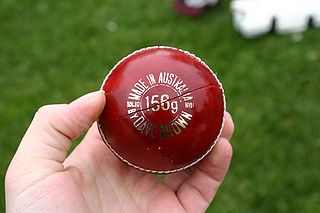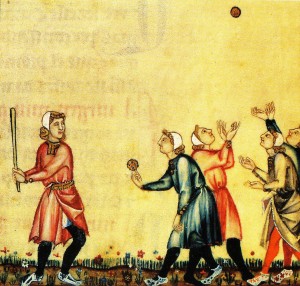
Test cricket is a form of first-class cricket played at international level between teams representing full member countries of the International Cricket Council (ICC). A match consists of four innings and is scheduled to last for up to five days. In the past, some Test matches had no time limit and were called Timeless Tests. The term "test match" was originally coined in 1861–62 but in a different context.
The Laws of Cricket is a code that specifies the rules of the game of cricket worldwide. The earliest known code was drafted in 1744. Since 1788, the code has been owned and maintained by the private Marylebone Cricket Club (MCC) in Lord's Cricket Ground, London. There are currently 42 Laws, which describe all aspects of how the game is to be played. MCC has re-coded the Laws six times, each with interim revisions that produce more than one edition. The most recent code, the seventh, was released in October 2017; its 3rd edition came into force on 1 October 2022.
In the game of cricket, the cricket pitch consists of the central strip of the cricket field between the wickets. It is 22 yd (20.12 m) long and 10 ft (3.05 m) wide. The surface is flat and is normally covered with extremely short grass, but can be completely dry or dusty soil with barely any grass or, in some circumstances, made from an artificial material. Over the course of a cricket match, the pitch is not repaired or altered other than in special circumstances - meaning that it will change condition. Any grass on the pitch in the game's first over, for example, may have disappeared by twentieth over due to wear.

This is a general glossary of the terminology used in the sport of cricket. Where words in a sentence are also defined elsewhere in this article, they appear in italics. Certain aspects of cricket terminology are explained in more detail in cricket statistics and the naming of fielding positions is explained at fielding (cricket).

In cricket, a no-ball is a type of illegal delivery to a batter. It is also a type of extra, being the run awarded to the batting team as a consequence of the illegal delivery. For most cricket games, especially amateur, the definition of all forms of no-ball is from the MCC Laws of Cricket.

A cricket bat is a specialised piece of equipment used by batters in the sport of cricket to hit the ball, typically consisting of a cane handle attached to a flat-fronted willow-wood blade. It may also be used by a batter who is making batter's ground to avoid a run out, by holding the bat and touching the ground with it. The length of the bat may be no more than 38 inches and the width no more than 4.25 inches. Its use is first mentioned in 1624. Since 1979, a law change has provided that cricket bats can only be made from wood.

A cricket ball is a hard, solid ball used to play cricket. A cricket ball consists of a cork core wound with string then a leather cover stitched on, and manufacture is regulated by cricket law at first-class level. The trajectory of a cricket ball when bowled, through movement in the air, and off the ground, is influenced by the action of the bowler and the condition of the ball and the pitch, while working on the cricket ball to obtain optimal condition is a key role of the fielding side. The principal method through which the batter scores runs is by hitting the ball, with the bat, into a position where it would be safe to take a run, or by directing the ball through or over the boundary. Cricket balls are harder and heavier than baseballs.

Indoor cricket is a variant of and shares many basic concepts with cricket. The game is most often played between two teams each consisting of six or eight players.

In cricket, batting is the act or skill of hitting the ball with a bat to score runs and prevent the loss of one's wicket. Any player who is currently batting is, since September 2021, officially referred to as a batter —regardless of whether batting is their particular area of expertise. Batters have to adapt to various conditions when playing on different cricket pitches, especially in different countries; therefore, as well as having outstanding physical batting skills, top-level batters will have quick reflexes, excellent decision-making skills, and be good strategists.
Fast bowling is one of two main approaches to bowling in the sport of cricket, the other being spin bowling. Practitioners of pace bowling are usually known as fast bowlers, quicks, or pacers. They can also be referred to as a seam bowler, a swing bowler or a fast bowler who can swing it to reflect the predominant characteristic of their deliveries. Strictly speaking, a pure swing bowler does not need to have a high degree of pace, though dedicated medium-pace swing bowlers are rarely seen at Test level in modern times.
Swing bowling is a technique used for bowling in the sport of cricket. Practitioners are known as swing bowlers. Swing bowling is generally classed as a subtype of fast bowling.
The outfield, in cricket, baseball and softball is the area of the field of play further from the batsman or batter than the infield. In association football, the outfield players are positioned outside the goal area.

In cricket, a run is the unit of scoring. The team with the most runs wins in many versions of the game, and always draws at worst, except for some results decided by the DLS method, which is used in rain-shortened limited-overs games when the two teams have had a different number of opportunities to score runs.
Baseball and cricket are the best-known members of a family of related bat-and-ball games. Both have fields that are 400 feet (120 m) or more in diameter between their furthest endpoints, offensive players who can hit a thrown/"bowled" ball out of the field and run between safe areas to score runs (points) at the risk of being gotten out, and have a major game format lasting about 3 hours.
Law 41 of the Laws of Cricket covers unfair play. This law has developed and expanded over time as various incidents of real life unfair play have been legislated against.
Danish longball is a bat-and-ball game similar to brännboll played in Denmark, Sweden and Norway. It is also played in some British secondary schools(Manor School), and is played recreationally by scouts, the Air Training Corps, Wetheringsett Camp Suffolk, and by the Royal Navy and Australian Navy. It is also played at some U.S. summer camps.

Kilikiti, also known as Samoan cricket or kirikiti, is one of several forms of the game of cricket. Originating in Samoa, it spread throughout Polynesia and can now be found around the world in areas with strong Polynesian populations. The game is the national sport of Samoa, and is played in many other Pacific countries, including amongst the Pacific Islander diaspora in Australia and New Zealand.

A pitch or a sports ground is an outdoor playing area for various sports. The term pitch is most commonly used in British English, while the comparable term in Australian, American and Canadian English is playing field or sports field.

Bat-and-ball games are field games played by two opposing teams. Action starts when the defending team throws a ball at a dedicated player of the attacking team, who tries to hit it with a bat and run between various safe areas in the field to score runs (points). The defending team can use the ball in various ways against the attacking team's players to force them off the field when they are not in safe zones, and thus prevent them from further scoring. The best known modern bat-and-ball games are cricket and baseball, with common roots in the 18th-century games played in England.

Cricket is a bat-and-ball game played between two teams of eleven players on a field at the centre of which is a 22-yard (20-metre) pitch with a wicket at each end, each comprising two bails balanced on three stumps. The batting side scores runs by striking the ball bowled at one of the wickets with the bat and then running between the wickets, while the bowling and fielding side tries to prevent this and dismiss each batter. Means of dismissal include being bowled, when the ball hits the stumps and dislodges the bails, and by the fielding side either catching the ball after it is hit by the bat, but before it hits the ground, or hitting a wicket with the ball before a batter can cross the crease in front of the wicket. When ten batters have been dismissed, the innings ends and the teams swap roles. The game is adjudicated by two umpires, aided by a third umpire and match referee in international matches. They communicate with two off-field scorers who record the match's statistical information.











